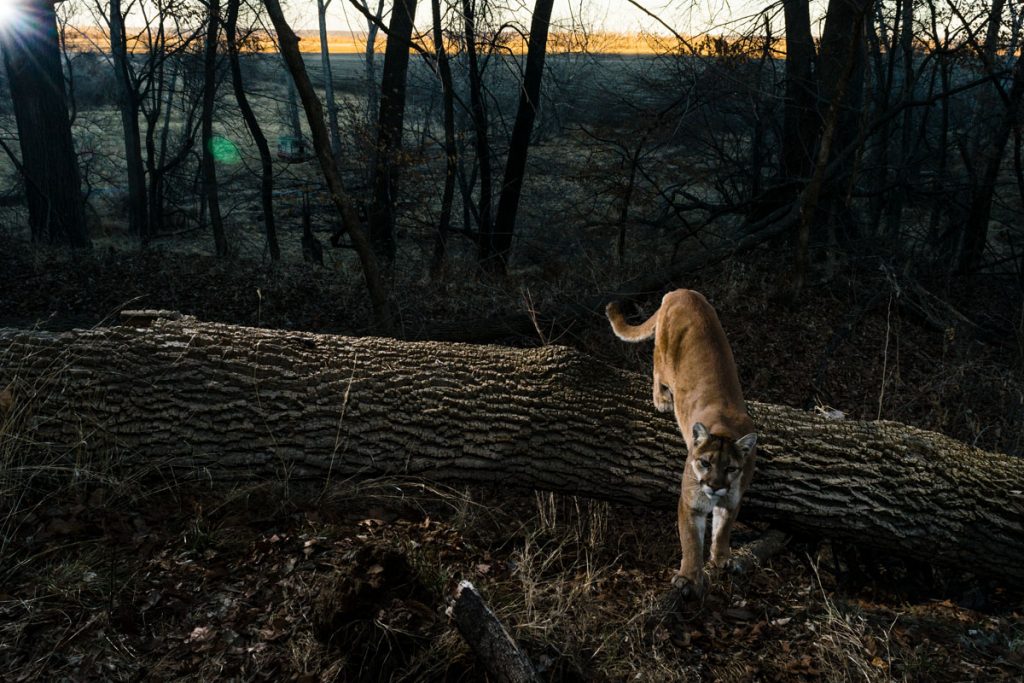
By Monica Macoubrie, Wildlife Education Specialist
The primordial pouch, also known as the “belly flap,” in felines is a natural accessory seen in our Nebraska mountain lions (Puma concolor) and bobcats (Lynx rufus). This pouch is an extra flap of loose skin and fatty tissue located along the length of the belly, extending from the lower abdomen to the hind legs. Contrary to the common misconception that it is simply a sign of obesity, the primordial pouch serves several important functions.
Protection of Internal Organs
When a cat engages in activities that involve physical confrontation, such as fighting with other cats or defending itself from predators, the primordial pouch provides an additional layer of protection. The loose, pliable nature of the skin allows it to absorb impacts and distribute the force over a wider area, reducing the likelihood of severe injuries to organs, such as the stomach, intestines and liver.
Additionally, the pouch can stretch and shift, accommodating the cat’s movements and further minimizing the risk of internal damage during intense physical exertion. This evolutionary adaptation is particularly advantageous for wild cats, such as mountain lions and bobcats, which often face aggressive encounters in their natural habitats. By providing a flexible yet protective barrier, the primordial pouch enhances the cat’s ability to withstand blows and bites, thereby improving its chances of survival in the wild.
Greater Flexibility
The primordial pouch contributes to a cat’s exceptional flexibility and movement. The loose nature of the pouch allows the skin to stretch and expand, giving the cat a greater range of motion during various activities. When a cat stretches, jumps or twists, the primordial pouch provides the necessary slack in the skin, preventing it from tearing, and allowing the cat to perform these actions more fluidly. This flexibility is critical for wild cats, aiding them in hunting, climbing and evading predators.
In the wild, mountain lions and bobcats rely on their agility to navigate diverse and often rugged terrains, to pounce on prey with precision and to quickly escape from threats.
Energy Storage
From stretching to protection, it’s hard to believe the primordial pouch does more. It also serves as a reservoir for extra energy. In the wild, where food availability can be unpredictable, this ability to store fat is particularly advantageous. During times of abundance, cats can consume more food than immediately necessary, and the excess energy is stored in the fat within the primordial pouch. This stored fat can then be metabolized during periods of scarcity, providing the cat with a critical energy reserve.
The primordial pouch offers a lifeline to wild cats at risk of facing extended periods without successful hunting. It helps to ensure the necessary energy reserves for sustaining vital bodily functions, maintaining muscle mass and supporting physical activities like hunting and defending territory. This energy storage capability is not just about survival; it also enhances the cat’s endurance and resilience, enabling it to thrive in diverse and often challenging environments.
The primordial pouch is a remarkable and multi-functional feature in cats, illustrating the sophisticated adaptations these animals have developed to thrive in their environments. From providing crucial protection to internal organs during physical confrontations to enhancing flexibility and facilitating agile movements, the primordial pouch plays a vital role in a cat’s survival and overall physical prowess.
